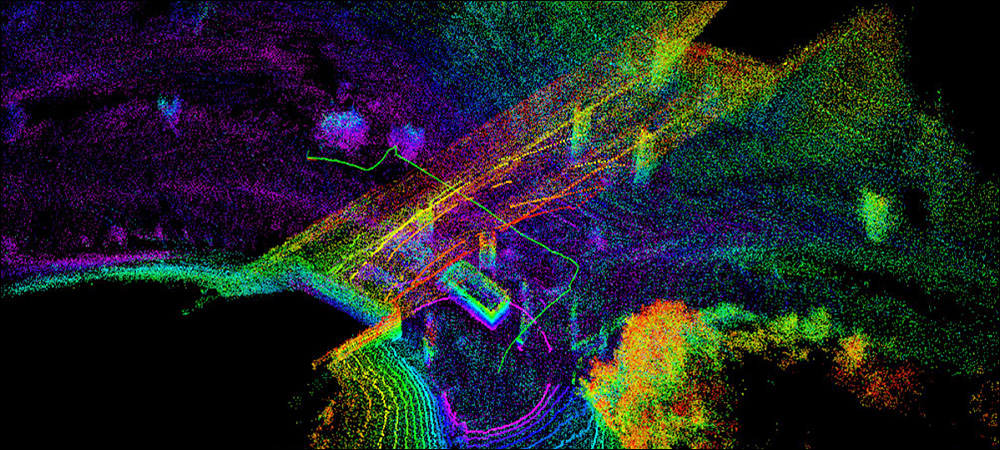Presented here are recent news announcements in the RFID and IoT industry.
- RF Code Intros Edge Monitoring Solution for Remote Locations
- Senet, Helium Expand LoRaWAN Connectivity Globally
- Kerlink Gateways Power SkyLab LoRaWAN for Wind Energy
- IoT Company UnaBiz Appointed New Sigfox Owner
- IIJ Global, Excelfore Boost Connected Car Software Security
- Auterion, Spleenlab Partner on Drones, AI for Inspections
RF Code Intros Edge Monitoring Solution for Remote Locations
RF Code, a provider of automated, real-time physical asset lifecycle-management and environmental-monitoring solutions for data centers, has announced the launch of its Sentry software-as-a-service product for decentralized edge-computing locations. Sentry provides autonomous and uninterrupted monitoring of unmanned IT locations at scale, the company reports. With deep intelligence and real-time notifications, the solution enables IT professionals to monitor all remote IT spaces without being onsite.
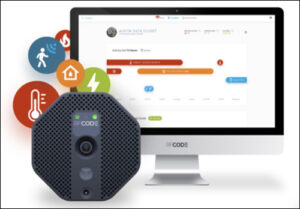 “I can honestly say the Sentry device from RF Code will be an industry game-changer,” said John Fletcher, a lead technology analyst at an unnamed retail IT firm, in a prepared statement. “You get three monitoring devices in one unit… temperature, humidity and camera monitoring. Sentry is very easy to set up and cost-effective for our team’s budget. It has real-time visual access and rich data of each IT environment that we’re monitoring. It also has thermal scanning so I can check any room that houses critical IT equipment for potential hotspots that would cause an outage in the future.”
“I can honestly say the Sentry device from RF Code will be an industry game-changer,” said John Fletcher, a lead technology analyst at an unnamed retail IT firm, in a prepared statement. “You get three monitoring devices in one unit… temperature, humidity and camera monitoring. Sentry is very easy to set up and cost-effective for our team’s budget. It has real-time visual access and rich data of each IT environment that we’re monitoring. It also has thermal scanning so I can check any room that houses critical IT equipment for potential hotspots that would cause an outage in the future.”
With the increasing adoption of Internet of Things (IoT) devices, autonomous vehicles and work-from-anywhere models, data-center functions are moving to the edge to support these compute-intensive, zero-latency applications and the demands of remote workforces, RF Code explains. By implementing a decentralized architecture, the company adds, retailers, hospitals, hotels, manufacturers and banks can improve localized computing power for end users. Without real-time environmental and critical asset monitoring tools in place, unplanned downtimes, thefts and breaches can result.
“We developed Sentry as a way to meet the needs of a broader, underserved edge market with a simple, scalable and affordable real-time IT asset- and environmental-monitoring solution,” said Dale Quayle, RF Code’s CEO, in the statement. “Enterprises of all sizes need the ability to see, hear and secure these edge environments as though they’re onsite, and Sentry makes it easier to prevent, mitigate or remediate IT situations that threaten to disrupt normal business operations—from air quality and overheating to unauthorized access and other potential threats.”
Senet, Helium Expand LoRaWAN Connectivity Globally
Senet, a provider of cloud-based software and services platforms that enable global connectivity and on-demand network buildouts for the Internet of Things, and Helium, a decentralized wireless network provider, have announced an expansion of their roaming integration to include Helium-compatible hotspots deployed globally. This expansion follows a network integration for U.S. customers and the delivery of integrated network mapping and planning tools designed to simplify the rollout of IoT solutions.
Senet’s Extended Coverage Services include global LoRaWAN network connectivity via more than 720,000 Helium-compatible hotspots in more than 55,000 cities and 170 countries. The Helium network broadens coverage in areas where Senet has deployed carrier-grade networks and provides access to LoRaWAN network connectivity for enterprise- and consumer-grade devices where Senet has not yet deployed carrier-grade services. As new hotspots are added to the Helium network, they will automatically contribute to Senet’s network coverage at no additional cost, the partners explain.
 For solution providers deploying commercial applications at scale, Senet provides a carrier-grade on-ramp to the Helium network. Through a suite of cloud-based services, solution providers partnered with Senet can onboard and operate their IoT devices using Helium-compatible hotspots, managed network services and customer support, including application management through a user portal or APIs, simplified billing, secure device provisioning and onboarding, network monitoring and management, notifications and alerts for application and network health, centralized device control and reporting, and customer-specific network mapping and system health tools.
For solution providers deploying commercial applications at scale, Senet provides a carrier-grade on-ramp to the Helium network. Through a suite of cloud-based services, solution providers partnered with Senet can onboard and operate their IoT devices using Helium-compatible hotspots, managed network services and customer support, including application management through a user portal or APIs, simplified billing, secure device provisioning and onboarding, network monitoring and management, notifications and alerts for application and network health, centralized device control and reporting, and customer-specific network mapping and system health tools.
“Expanding Senet’s integration with the Helium network is an example of our combined interest in delivering LoRaWAN coverage at a global scale for the widest range of use cases,” said Bruce Chatterley, Senet’s CEO, in a prepared statement. “The growth of the Helium network has been explosive, and as solution deployments grow in scale, robust network- and device-management services are becoming increasingly important. Through our Extended Coverage and managed services on-ramp to the Helium network, solution providers benefit from greater coverage and consistency in operational service, which are vital to success.”
In addition, Senet says it has enhanced its network-planning and coverage-visualization tools. Features unique to the company’s integration with the Helium network include global and integrated display of Senet and Helium public network coverage from a dynamically updated map, as well as interactive capabilities, including zip code search and zoom functionality, allowing users to view coverage available at any location. Senet customers can “drop a pin” on a network-planning map via a mouse click, resulting in the display of path quality to that location from the Senet network and the number of Helium-compatible gateways within proximity.
“Senet has been a trailblazer in innovating around LoRaWAN service delivery, and they continue to drive market adoption of low-power wide-area networks for large-scale commercial applications,” added Scott Sigel, Helium’s COO, in the statement. “With our expanded network integration and Senet’s managed services approach to onboarding and supporting solution providers, we look forward to entering more markets, faster and with more opportunity for scale.”
Kerlink Gateways Power SkyLab LoRaWAN for Wind Energy
Kerlink, a provider of solutions dedicated to the Internet of Things, has announced that its Wirnet iStation gateways are powering multiple LoRaWAN networks in wind-energy parks above the North Sea in the Netherlands. One gateway installed on the Borssele Alpha platform, managed by Dutch transmission system operator TenneT Holding, links 700 MW of offshore wind farms to the Dutch power grid. The LoRaWAN network, deployed and operated by SkyLab B.V., Kerlink’s partner in the Netherlands, enables a variety of safety applications, such as search-and-rescue systems, life jackets with precision location capabilities, emergency-location beacons and buoy trackers.
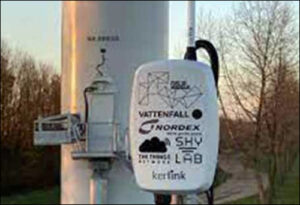 SkyLab’s deployment comprises outdoor industrial-grade LoRaWAN Wirnet iStation gateways, with a feature called “dual packet forwarder” that enables the orchestration of data transmission simultaneously on multiple LoRaWAN networks. This, according to the company, increases connectivity in the North Sea area for all potential users, which include shippers, electricity providers, consumers, and businesses and area residents. Private, public and commercial networks can thus run simultaneously.
SkyLab’s deployment comprises outdoor industrial-grade LoRaWAN Wirnet iStation gateways, with a feature called “dual packet forwarder” that enables the orchestration of data transmission simultaneously on multiple LoRaWAN networks. This, according to the company, increases connectivity in the North Sea area for all potential users, which include shippers, electricity providers, consumers, and businesses and area residents. Private, public and commercial networks can thus run simultaneously.
“This LoRaWAN deployment is unique because it serves multiple-user LoRaWAN networks,” explained Remy de Jong, SkyLab’s director, in a prepared statement. “It supplies IoT coverage to a challenging and sometimes harsh North Sea environment, high above ground level on platforms and wind turbines. The result enables smart applications and all types of wireless sensors and devices where they have not been deployed previously.” The North Sea connectivity will support safety applications such as search-and-rescue operations, as well as climate and weather monitoring.
“This project with SkyLab demonstrates the continuously growing range of IoT deployments that can improve business efficiency, customer service and safety,” added Stéphane Dejean, Kerlink’s CMO, in the statement. “As with Kerlink’s previous projects in the Netherlands that are bringing cost-efficient LoRaWAN connectivity with multiple benefits to new and existing business sectors, these applications will find new markets that want to deploy them, leveraging Kerlink IoT gateways’ proven performance, robustness and reliability.”
IoT Company UnaBiz Appointed New Sigfox Owner
The Commercial Court of Toulouse, France, has announced the appointment of UnaBiz, an IoT service provider and Sigfox operator for Singapore and Taiwan, as Sigfox’s new owner (see IoT Network Provider Sigfox, with Bankruptcy Protection, Seeks Buyers). The results of the receivership proceeding for Sigfox and its subsidiary, Sigfox France SAS, were unanimous, with UnaBiz endorsed as the best offer among nine initial bidders by the jury, administrators and public prosecutor, as well as Sigfox SA, Sigfox France SAS and Sigfox’s employee representatives.
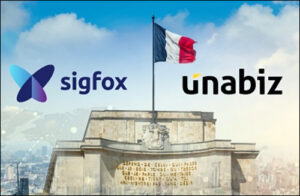 UnaBiz provides sensor product design, manufacturing and data-platform services for a hybrid of low-power wide-area (LPWA) technologies such as Sigfox, LTE-M, NB-IoT and LoRa. The firm has deployed more than 1.4 million sensors in 28 countries for such smart-city applications as smart metering, facilities management, asset management and asset tracking. The various parties will work alongside UnaBiz to ensure a smooth transition of ownership to Sigfox’s existing commercial activities. Upon handover, UnaBiz will safeguard 110 existing employees out of 174 and make financial and operational assessments to protect the firm’s assets, books, and mission-critical network and back-end systems.
UnaBiz provides sensor product design, manufacturing and data-platform services for a hybrid of low-power wide-area (LPWA) technologies such as Sigfox, LTE-M, NB-IoT and LoRa. The firm has deployed more than 1.4 million sensors in 28 countries for such smart-city applications as smart metering, facilities management, asset management and asset tracking. The various parties will work alongside UnaBiz to ensure a smooth transition of ownership to Sigfox’s existing commercial activities. Upon handover, UnaBiz will safeguard 110 existing employees out of 174 and make financial and operational assessments to protect the firm’s assets, books, and mission-critical network and back-end systems.
“I want to thank the entire Sigfox community for supporting us, and the French government for authorizing our investment,” said Henri Bong, UnaBiz’s co-founder and co-CEO, in a prepared statement. “While the transition of ownership marks a new beginning for Sigfox, UnaBiz will definitely guarantee the French sovereignty of Sigfox. On top of securing the sales pipeline for Sigfox in the next 12 months as global markets emerge from the pandemic, UnaBiz and Sigfox will strive toward the convergence of LPWAN. The new Sigfox will reinvent itself and collaborate with other IoT communication technologies to seize new market opportunities.”
To establish a more durable and collaborative global ecosystem, UnaBiz plans to put in place new strategies and governance that will enable it to facilitate engagements with Sigfox’s existing partners, customers and operators. The goal, according to the company, is to align stakeholders’ interests and support its long-term development.
IIJ Global, Excelfore Boost Connected Car Software Security
Excelfore, a provider of connected car technologies, is collaborating with IIJ Global on the development of a security solution for in-vehicle software in connected cars. This partnership, the companies explain, is intended to ensure compliance with the UNECE WP.29 automotive regulations for software installation and updates. Under the terms of the agreement, Excelfore’s eSync over-the-air (OTA) software-update system will be integrated with IIJ Global’s IoT Kusabi Service security infrastructure.
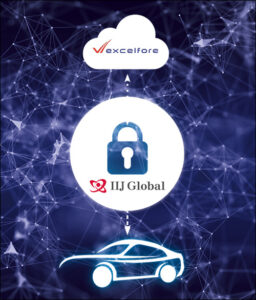 The IoT Kusabi Service will issue security certificates for the eSync server in the cloud as part of the eSync server/client/agent architecture. During an OTA software update, the eSync system uses this certificate to confirm the link’s security before transmitting the update. The information authenticated by the IoT Kusabi Service is linked to and managed by the eSync server.
The IoT Kusabi Service will issue security certificates for the eSync server in the cloud as part of the eSync server/client/agent architecture. During an OTA software update, the eSync system uses this certificate to confirm the link’s security before transmitting the update. The information authenticated by the IoT Kusabi Service is linked to and managed by the eSync server.
“It can be challenging for automakers to ensure compliance with the WP.29 regulations,” explained Shrinath Acharya, Excelfore’s CEO, in a prepared statement. “Working together, IIJ Global and Excelfore provide a robust, fully compliant platform for OTA updates.” WP.29 is a set of automotive regulations within the framework of the United Nations Economic Commission for Europe. Under regulations published within WP.29, vehicles that support wireless software updates must prove that security is protected by the cybersecurity management system during development, manufacturing and post-manufacturing.
To meet this regulation, the system requires mechanisms that keep automotive software information secure and well-protected. Excelfore provides an OTA data pipeline to handle secure bidirectional transmission between in-vehicle electronic systems, and remote processing and storage in the cloud. The OTA pipeline is a full implementation of the eSync standard, which is published by the eSync Alliance. The eSync platform can update software and firmware over the air, while collecting real-time operational data from in-car devices, including ECUs, domain master ECUs, network gateways and smart sensors.
The IoT Kusabi Service is a new public key infrastructure system and management service developed using technology patented by IVJ Co. The platform service is designed to prove the legitimacy and safety of IoT devices and firmware, the company reports, as well as prevent spoofing and tampering. The security solution is scheduled for full-scale services starting in October 2022.
Auterion, Spleenlab Partner on Drones, AI for Infrastructure Inspection
Auterion, which provides an open, software-defined environment for enterprise drone fleets, has added Spleenlab to its ecosystem. According to the company, Spleenlab’s Visionary technology offers artificial intelligence (AI)-based safe-perception software for drones, enabling them to complete fully autonomous infrastructure detection, inspection and collision avoidance.
“Together with Spleenlab, we’re demonstrating that the future of robotics is now with our combined AI, machine learning and onboard edge technologies,” said Markus Achtelik, Auterion’s VP of engineering, in a prepared statement. “This new partnership brings together the best technologies—Auterion’s Skynode and AI Node with Spleenlab’s Visionary perception software—to deliver the best possible autonomous solutions for enterprise drone users.”
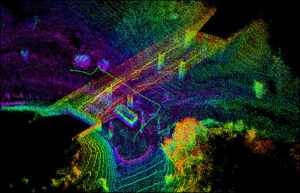 Visionary AI is combined with AI Node, a supercomputer for embedded and edge systems. The combination runs AI at the edge onboard any drone, the company reports. Software running on the Auterion ecosystem enables the autonomous inspection of critical infrastructure, empowering enterprise users to scale beyond single-pilot, single-drone operations.
Visionary AI is combined with AI Node, a supercomputer for embedded and edge systems. The combination runs AI at the edge onboard any drone, the company reports. Software running on the Auterion ecosystem enables the autonomous inspection of critical infrastructure, empowering enterprise users to scale beyond single-pilot, single-drone operations.
“We’re excited to collaborate with Auterion to take this next step into an autonomous future,” said Stefan Milz, Spleenlab’s founder, in the statement. “Advanced ML algorithms are computation-heavy and require appropriate horsepower to be deployed onboard mobile robots. With Auterion’s Skynode and AI Node, the Visionary AI software can easily be deployed and run onboard drones on a high safety level.”
When the Visionary software and ML algorithm are installed on AI Node, the technologies enable drones to automate inspections, avoid collisions, detect and track objects for automated flight maneuvers, detect obstacles in the air or on the ground, and estimate air and ground risk, the companies explain. Enterprise drones can thus understand their environment and predict safe landing spots in real time for package delivery, emergencies and other situations. Risk estimation includes detecting cooperative and non-cooperative air traffic, with a field of view of up to 360 degrees and a range of several kilometers.
Exhibitors at RFID Journal LIVE! 2022 will offer tagging and tracking solutions for a wide variety of industries. To learn more, visit the event’s website.

